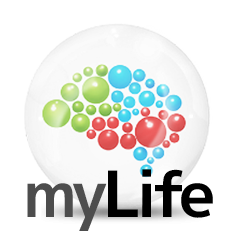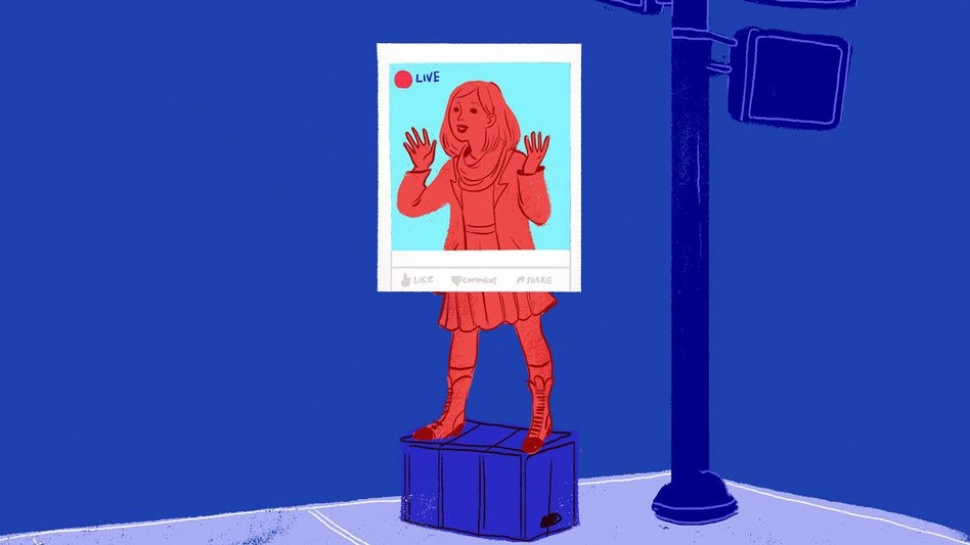The towering murals assure you that it’s normal to broadcast live video of your daily life using the new Facebook Live feature. It's not.
One ad in Brooklyn reads, “How to go LIVE if you’re reading Tolstoy in public and nobody’s impressed.”
There isn't anything less worthy of a person's full attention than their Facebook friend reading Russian literature out loud.
For many, Live may simply be too intimate. Inviting acquaintances from high school, extended family members and former colleagues to watch your livestream is awkward and feels intrusive. Imagine keeping up the fun when someone unexpected shows up.
For media companies, the format makes sense. It's given outlets like Mashable the opportunity to interview interesting people in real time, broadcast sports games, and stream history-making events.
But digital media companies don't always know what to do with the platform. Some brands have used it for complete nonsense to capture viewers' attention, and increase their publication's "reach" in your News Feed.
BuzzFeed famously blew up a watermelon by tying over 600 rubber bands to it for 45 minutes. The Daily Dot was "live" for more than three hours on Tuesday honoring Carrie Fisher's death. But it was looping the same video over and over again — certainly not live in any real sense.
When Live is better than pre-recorded
Facebook Live isn’t altogether superfluous. There are instances where its ability to bring us to an important event makes all the difference.
In July, Minnesota resident Philando Castile was pulled over for a broken tail light with his girlfriend Diamond Reynolds in the passenger seat. When Officer Jeronimo Yanez approached Castile, the situation turned tragic. Yanez allegedly shot Castile four times with little provocation. Reynolds’ 4-year-old daughter witnessed the shooting from the backseat.
Reynolds took out her cellphone and began streaming the aftermath on Facebook Live. Without Live, the public may have been forced to rely on the officer's account of the incident to make sense of what happened.
Instead, Yanez was charged with second-degree manslaughter and two felony counts of dangerous discharge of a firearm.
While you can't draw a straight line from Reynolds' live footage of the shooting's aftermath to Minnesota's decision to charge the officer, the numbers tell an impressive story. The 10-minute graphic video was viewed more than 3.2 million times within hours of the event.
The day after the shooting, Mark Zuckerberg himself noted how Facebook Live allowed the country to see the realities of police brutality in an unprecedented way.
“While I hope we never have to see another video like Diamond's, it reminds us why coming together to build a more open and connected world is so important — and how far we still have to go,” he wrote on his Facebook page.
Of course, nothing is so simple. While Reynolds' footage documented a harsh reality, it’s not hard to fabricate a Facebook Live experience. In October for example, viral Facebook pages successfully passed off old clips of space as live footage to millions. That's dangerous, because on the surface the medium can feel so intimate that we automatically believe what individuals use it to show us.

Bottom line: It's just not necessary. Usually.
Consider Snapchat, which provides its users with a quasi-live experience.
Instead of going live at a concert and intrusively demanding the full attention of your friends and family, you can record 10-second highlights to your Snapchat Story, which they can view within 24 hours before the clips erase automatically.
Even the most entertaining Facebook Live streams mostly consist of waiting around for the exciting parts to happen. For example, the only really gratifying part of the 45 minute BuzzFeed Live is when the watermelon finally exploded. The first 40 minutes merely consisted of watching two employees tie rubber bands to a fruit.
Still, the social network is pushing live video — hard. Facebook just launched the ability to go live on to Instagram, which it owns.
Also new is a Live Audio option, which suggests Facebook knows people don't want to be stuck looking at their News Feeds.
"We know that people often like to listen to audio while doing other things," Facebook Product Specialist Shirley Ip and Software Engineer Bhavana Radhakrishnan wrote in a blog post introducing the feature. You can turn it on and continue doing other stuff on your phone.
It also rolled out a video tab on the site that allows users to scroll through Live and other videos from pages they follow.
Lastly, Facebook announced "Live 360," a feature that allows videographers to post 360-degree live video to the platform. It will roll out to personal profiles next year, but you'll need a special camera to use it.
These products have potential. With more than 1.7 billion active users per month, the social giant has the ability to redefine how breaking news unfolds. The problem is that your daily life is not breaking news.
Unless you witness something groundbreaking, please, please don’t go live.
Thanks to Mashable




Share the News